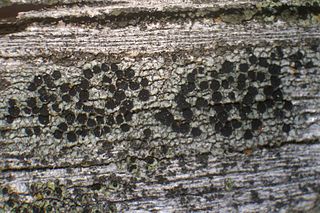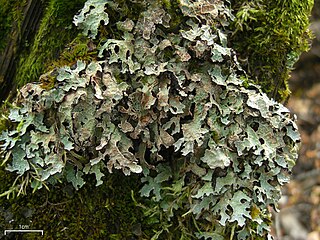
Beginning in 1867, a lichen was understood as a symbiosis of an algae or cyanobacteria, living among filaments of multiple fungi species. In 2016, new research by T. Spribille et al. revealed a third partner, a yeast imbedded in the lichen cortex or "skin."

Xanthoria parietina is a foliose lichen in the family Teloschistaceae. It has wide distribution, and many common names such as common orange lichen, yellow scale, maritime sunburst lichen and shore lichen. It can be found near the shore on rocks or walls, and also on inland rocks, walls, or tree bark. It was chosen as a model organism for genomic sequencing by the US Department of Energy Joint Genome Institute (JGI).
Vernon Ahmadjian was a distinguished professor at Clark University in Worcester, Massachusetts. He specialized in the symbiosis of lichens, and wrote several books and numerous publications on the subject.
Characiosiphon is a genus of green algae in the family Characiosiphonaceae. It contains a single species, Characiosiphon rivularis.

Neochloris is a genus of green algae in the family Neochloridaceae. It is found in freshwater aquatic and terrestrial soil habitats.
Planktosphaeria is a genus of green algae, specifically of the Chlorophyceae. It was first described by the phycologist Gilbert Morgan Smith in 1918, with Planktosphaeria gelatinosa as its type species. Species of Planktosphaeria are commonly found in freshwater plankton around the world.

Tetraspora is a genus of green algae in the family Tetrasporaceae of the order Chlamydomonadales, division Chlorophyta. Species of Tetraspora are unicellular green algae that exist in arrangements of four and consist of cells being packaged together in a gelatinous envelope that creates macroscopic colonies. These are primarily freshwater organisms, although there have been few cases where they have been found inhabiting marine environments and even contaminated water bodies. Tetraspora species can be found all around the globe, except in Antarctica. Despite the ubiquitous presence, the greatest growth of the genera's species is seen in the polar climatic zones.

Trebouxia is a unicellular green alga. It is a photosynthetic organism that can exist in almost all habitats found in polar, tropical, and temperate regions. It can either exist in a symbiotic relationship with fungi in the form of lichen or it can survive independently as a free-living organism alone or in colonies. Trebouxia is the most common photobiont in extant lichens. It is a primary producer of marine, freshwater and terrestrial ecosystems. It uses carotenoids and chlorophyll a and b to harvest energy from the sun and provide nutrients to various animals and insects.

Buellia is a genus of mostly lichen-forming fungi in the family Caliciaceae. The fungi are usually part of a crustose lichen. In this case, the lichen species is given the same name as the fungus. But members may also grow as parasites on lichens (lichenicolous). The algae in the lichen is always a member of the genus Trebouxia.

Pilophorus acicularis, commonly known as the nail lichen or the devil's matchstick lichen, is a species of matchstick lichen in the family Cladoniaceae.
Lichen anatomy and physiology is very different from the anatomy and physiology of the fungus and/or algae and/or cyanobacteria that make up the lichen when growing apart from the lichen, either naturally, or in culture. The fungal partner is called the mycobiont. The photosynthetic partner, algae or cyanobacteria, is called the photobiont. The body of a lichens that does not contain reproductive parts of the fungus is called the thallus. The thallus is different from those of either the fungus or alga growing separately. The fungus surrounds the algal cells, often enclosing them within complex fungal tissues unique to lichen associations. In many species the fungus penetrates the algal cell wall, forming penetration pegs or haustoria similar to those produced by pathogenic fungi. Lichens are capable of surviving extremely low levels of water content (poikilohydric). However, the re-configuration of membranes following a period of dehydration requires several minutes at least.

Symbiosis in lichens is the mutually beneficial symbiotic relationship of green algae and/or blue-green algae (cyanobacteria) living among filaments of a fungus, forming lichen.
Teuvoa is a genus of lichen-forming fungi in the family Megasporaceae. It was first classified by lichenologists Mohammad Sohrabi and Steven Leavitt in 2013, with Teuvoa uxoris asigned as the type species. This genus was delineated from the larger genus, Aspicilia, following a molecular phylogenetic analysis which revealed that the Aspicilia uxoris species group constituted a distinct lineage in the Megasporaceae. Initially containing three species, two additional species native to China were added in 2018. Teuvoa is characterised by its small ascospores and conidia, and the absence of secondary metabolites.

Parmelia barrenoae is a species of foliose lichen in the large family Parmeliaceae. It was formally described as a new species in 2005. Before this, it was lumped together as one of several lichens in the Parmelia sulcata group—a species complex of genetically distinct lookalikes. Parmelia barrenoae is widely distributed, occurring in Europe, western North America, Africa, and Asia.
Wahlenbergiella tavaresiae is a species of saxicolous (rock-dwelling), crustose lichen in the family Verrucariaceae. Known from several locations in the San Francisco Bay area of the United States, it is a marine lichen that inhabits intertidal zones, and as such is immersed in seawater on a regular basis. Associated algal species include the red algae Hildenbrandia and Mastocarpus papillatus, and the brown algae Pelvetiopsis and Fucus. Petroderma maculiforme, a brown alga, is the photobiont partner in the lichen.
Trebouxia decolorans is a widespread and common symbiotic species of green alga that is found in association with different species of lichen-forming fungi. Some lichens in which it is the photobiont partner are Xanthoria parietina and Anaptychia ciliaris.
Trebouxia arboricola is a symbiotic species of green alga in the family Trebouxiaceae. Described as new to science in 1924, it is usually found in association with different species of lichen-forming fungi and has a broad global distribution.
Placolecis sublaevis is a species of saxicolous (rock-dwelling), crustose lichen in the family Catillariaceae. It is found in Yunnan and Sichuan, China. The crust-like, radiating body of the lichen forms irregular patches or clumps and includes numerous false conidiomata, a type of asexual reproductive structure, within its thallus. Its lobes, dark brown and slightly flattened at the top, form larger groups at the edges and contain an upper layer composed of loosely interwoven cells and a lower inner tissue that varies from reddish-orange to white.
Asterochloris is a genus of green algae in the family Trebouxiophyceae. It is a common photobiont in lichen, occurring in the thalli of more than 20 lichen genera worldwide. Asterochloris is distinguishable from the morphologically similar genus Trebouxia, primarily due to its deeply lobed chloroplast, the placement of the chloroplast along the cell's periphery before the initiation of zoospore or aplanospore formation, and its tendency to primarily reproduce asexually through the production of aplanospores.
Asterochloris italiana is a species of green alga in the family Trebouxiaceae. It was first formally described by the phycologist Patricia A. Archibald in 1975, as a species of Trebouxia. It was transferred to the genus Asterochloris in 2010.








